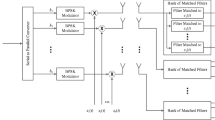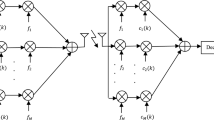Abstract
On the basis of CFO (carrier frequency offset) point of view, the system performance results from the analysis by adopting the channel scenarios characterized as Weibull fading for an MC-DS-CDMA (multi-carrier direct-sequence coded-division multiple-access) system is proposed in this article. Moreover, an approximate simple expression with the criterion of BER (bit error rate) versus SNR (signal-to-noise ratio) method is derived for an MC-DS-CDMA system combining with RAKE receiver, which is a special case of MRC (maximal ratio combining) diversity, based on the MGF (moment generating function) formula of Weibull statistics, and it associates with an alternative expression of Gaussian Q-function. In addition, the other point of view on the BER performance evaluation of an MC-DS-CDMA system is not only the assumption of both single-user and multi-user cases applied, but the phenomena of PBI (partial band interference) is also included. Furthermore, with several of the system parameters, such as CFO values, ε, Weibull fading parameter, β, user number, K, spreading chip number, N, branch number, L, and the PBI values, JSR etc., are compared with each other in the numerical results in order to validate the accuracy in the derived formulas. To the best of author’s knowledge, it is a brain fresh idea proposed in this paper to evaluate the system performance for an MC-DS-CDMA system on the point of the CFO view over Weibull fading.
Similar content being viewed by others

References
Yang L.-L., Hanzo L. (2003) Multicarrier DS-CDMA: A multiple access scheme for Ubiquitous broadband wireless communications. IEEE Communications Magazine 41(10): 116–124
Prasad R., Hara S. (1999) Overview of multicarrier CDMA. IEEE Communications Magazine 35(12): 126–133
Nee R. V., Prasad R. (2000) OFDM for wireless multimedia communication. Artech House, Boston, London
Kondo S., Milstein B. L. (1996) Performance of multicarrier DS-CDMA system. IEEE Transactions on Communications 44: 238–246
Yee N., Linnartz J.-P., Fettweis G. (1994) Multi-carrier CDMA in indoor wireless radio networks. IEICE Transactions on Communications E77-B: 900–904
Ziemer R. E., Nadgauda N. (1996) Effect of correlation between subcarriers of an MC/DSSS communication system. TEEE Vehicular Technology 46th Conference 1: 146–150
Shi Q., Latva-aho M. (2003) Performance analysis of MC-CDMA in Rayleigh fading channels with correlated envelopes and phase. IEE Proceedings Communications 150: 210–214
Kim, T., Kim, Y., Park, J., Ko, K., Choi, S., Kong, C. et al. (2000). Performance of an MC-CDMA System with frequency offset in correlated fading. IEEE international conference on Communications, 18–22
Xu W., Milstein L. B. (1997) Performance of multicarrier DS-CDMA system in the presence of correlated fading. IEEE Vehicular Technology Conference 3: 2050–5054
Yang L.-L., Hanzo L. (2002) Performance of generalized multicarrier DS-CDMA over Nakagami-m fading channels. IEEE Transactions on Communications 50(6): 956–966
Kang Z, Yao K. (2004) On the performance of MC-CDMA over frequency-selective Nakagami-m fading channels with correlated and independent subcarriers. Global Telecommunications Conference 5: 2859–2863
Shi Q., Latva-aho M. (2005) Accurate bit-error rate evaluation for synchronous MC-CDMA over Nakagami-m-fading channels using moment generating functions. IEEE TransWireless Communications 4(2): 422–433
Chen J. I.-Z. (2006) Performance analysis of MC-CDMA communication systems over Nakagami-m environments. Journal of Marine Science and Technology 14(1): 58–63
Weibull, W. (1951). A statistical distribution function of wide applicability. Applied Mechanics Journal, 27.
Karagiannidis G. K., Zogas D. A., Kotsopoulos S. A. (2003) On the multivariate Nakagami-m distribution with exponential correlation. IEEE Transactions on Communications 51(8): 1240–1244
Alouini M.-S., Simon M. K. (2006) Performance of generalized selection combining over Weibull fading channels. Wireless Mobile Communications 8: 1077–1084
Sagias N. C., Zogas D. A., Karagiannidis G. K, Tombras G. S. (2003) Performance analysis of switched diversity receivers in Weibull fading. Electron Letter 39(20): 1472–1474
Sagias N. C., Karagiannidis G. K., Zogas D. A., Mathiopoulos P. T., Tombras G. S. (2004) Performance of dual selection diversity in correlated Weibull fading channels. IEEE Transactions on Communications 52(7): 1063–1067
Chen J. I.-Z. (2006) Average LCR and AFD for SC diversity over correlated Weibull fading channels. International Journal of Wireless Personal Communications 39(2): 151–163
Karagiannidis G. K., Zogas D. A, Sagias N. C, Kotsopoulos S. A., Tombras G. S. (2005) Equal-gain and maximal-ratio combining over Weibull fading channels. IEEE Transactions on Wireless Communications 4(3): 841–846
Smida B., Despins C. L., Delisle G. Y. (2001) MC-CDMA performance evaluation over a multipath fading channel using the characteristic function method. IEEE Transactions on Communications 49: 1325–1328
Sagias N. C., Karagiannidis G. K. (2005) Gaussian class multivariate Weibull distributions: Theory and applications in fading channels. IEEE Transactions Information Theory 51(10): 3608–3619
Rugini L., Banelli P. (2005) BER of OFDM system impaired by carrier frequency offset in multipath fading channels. IEEE Transactions on Communications 4(5): 2279–2288
Liu, X., & Hanzo, L. (2007). Exact BER analysis of OFDM systems communicating over frequency-selective fading channels subjected to carrier frequency offset. In IEEE Vehicular Technology Conference, VTC2007 spring (pp. 1951–1955). Dublin, Ireland 22–25, April.
Zhou, S., Zhang, K., & Niu, Z. (2007). On the impact of carrier frequency offset in OFDM/SDMA systems. In Proceedings of IEEE International Communications Conference, pp. 4867–4872.
Chen J. I.-Z. (2007) The impact on channel correlation for MC-DS-CDMA system in small-scale fading environments. International Journal of Wireless Personal Communications 41(4): 471–485
Xiang G., Tung S. N. (1999) Performance of asynchronous orthogonal multicarrier CDMA system in frequency selective fading channel. IEEE Transactions on Communications 47(7): 1084–1091
Gradshteyn I. S., Ryzhik I. M. (1994) Table of integrals, series, and products (5th ed.). Academic Press, San Diego, CA
Author information
Authors and Affiliations
Corresponding author
Rights and permissions
About this article
Cite this article
Chen, J.IZ., Kuo, W.C. On the Impact of CFO for an MC-DS-CDMA System in Weibull Fading Environments. Wireless Pers Commun 63, 785–805 (2012). https://doi.org/10.1007/s11277-010-0165-7
Published:
Issue Date:
DOI: https://doi.org/10.1007/s11277-010-0165-7



